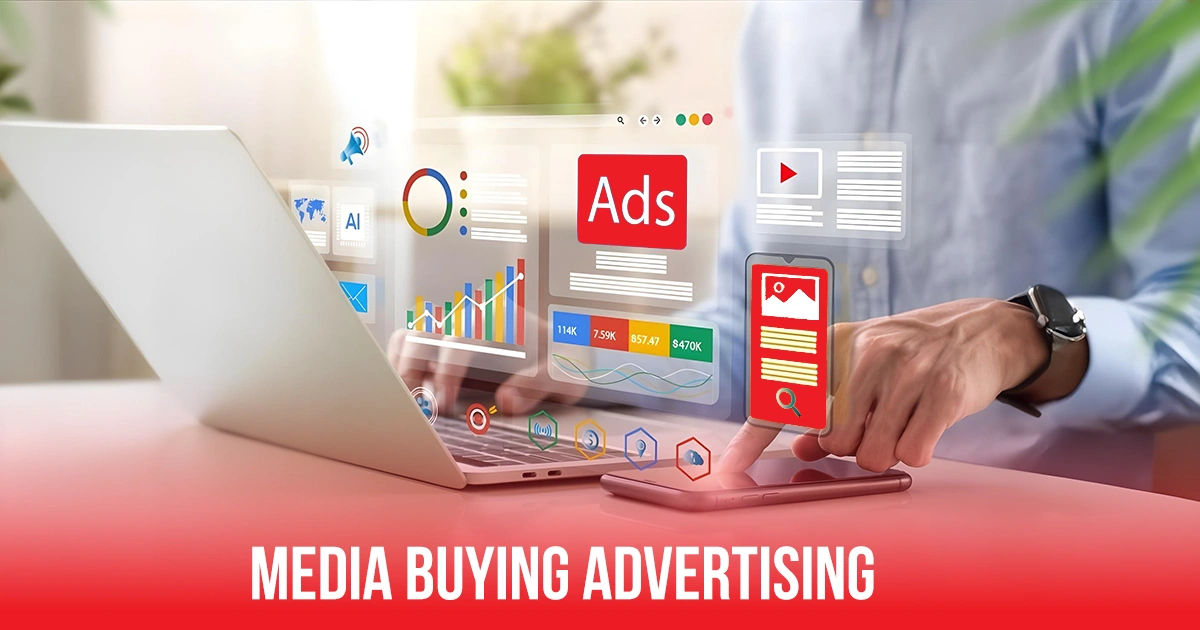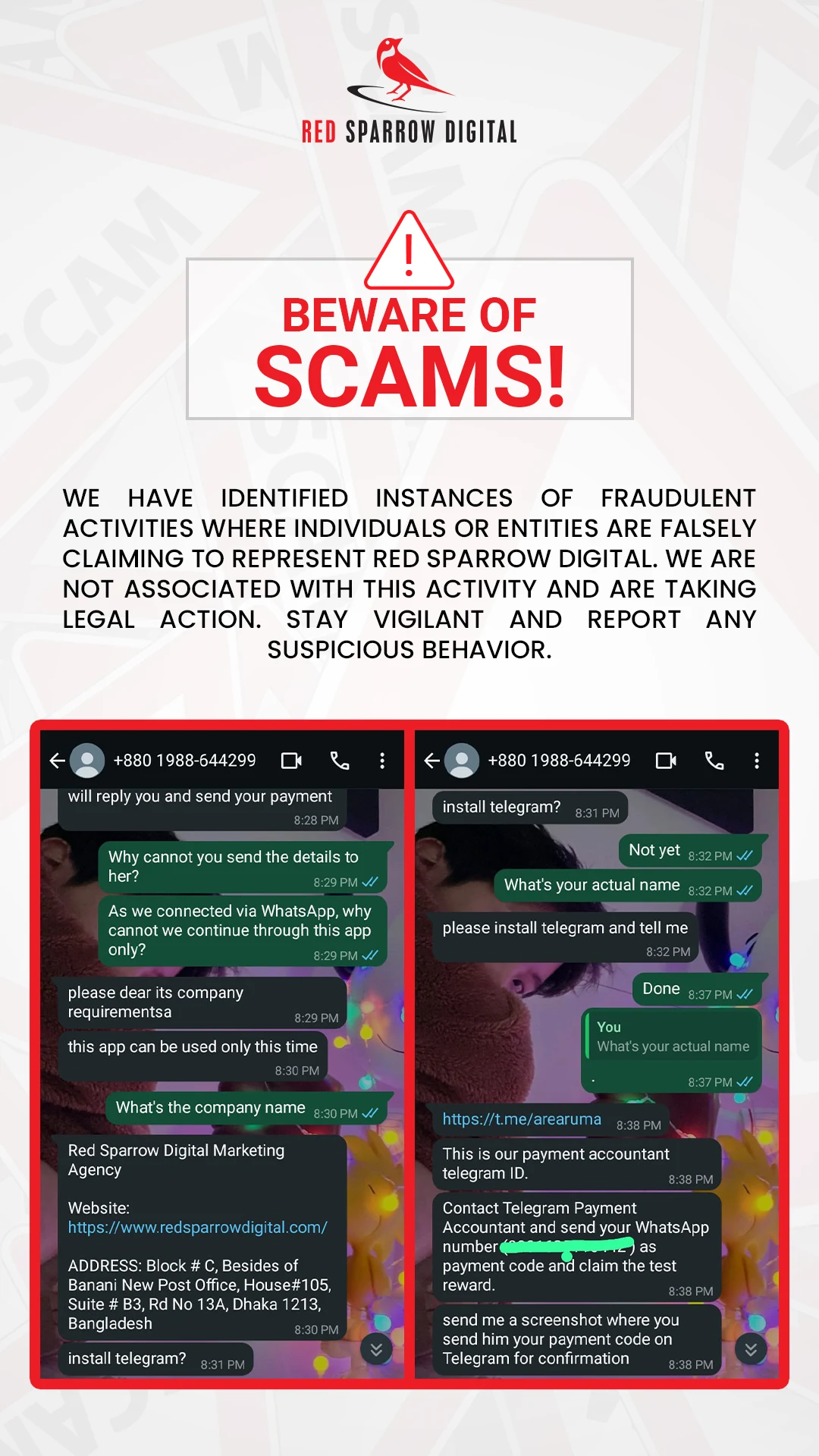Maximize Impact & Minimize Cost with the Best Advertising Agency in Bangladesh
Media buying is a process in advertising and marketing where companies advertise online through Google, Facebook, LinkedIn, Instagram, YouTube, TikTok, and more to promote their products and services. The goal of media buying is to run targeted ads efficiently to lower overall campaign costs. At Red Sparrow Digital, we provide excellent media planning services that allow you to purchase designated online space to run your ads. These spaces guarantee higher views and clicks because they are strategically placed where the majority of the customers are. We specialize in running successful Facebook ad campaigns, making us a top Facebook ad agency in Dhaka, Bangladesh.
According to Fact.MR, the global media buying services market was valued at USD 69 billion in 2022 and is projected to grow at a CAGR of 6.2%, reaching USD 125.9 billion by the end of 2032. Now is the perfect opportunity to take action and get your business noticed.
What is Media Buying & Advertising?

Let’s clear up some confusion first: the terms media buying and advertising are often used interchangeably, even though media buying is just one step within the broader process of advertising. Advertising typically refers to the overarching strategy, including media buying, creative development, and campaign planning. However, in this context, running ads in designated spaces is also referred to as advertising.
Media buying involves securing the best prices for ad placements, determining optimal timing for ads to maximize visibility and engagement, and tracking ad performance to ensure delivery meets expectations. Since media buying focuses on ads, it’s often grouped together with advertising as “media buying and advertising”.
The main goal of this process, regardless of what you call it, is to promote a product, service, or business by paying for increased visibility among potential customers. This promotion can serve various purposes, such as strengthening brand identity, raising awareness, attracting customers, or generating revenue.
What Are the Benefits of Our Media Buying & Advertising Solutions?
What Media Buying & Advertising Services Do We Offer?
We understand that media buying and advertising hold the potential to take your brand to a new level of success. That’s why we focus on maximizing their value by offering services that align with your budget. Our approach combines creativity, data-driven insights, and industry expertise to deliver your message to the right audience at the right time. Here's an overview of our services:
Google Ads
Google Ads is a powerful online advertising platform that allows businesses to reach their target audience across multiple channels. Using this platform, advertisers can target specific audiences based on demographics, interests, and website placements to achieve specific goals, including brand visibility, lead generation, and app promotion.
Here are some of the key elements of Google Ads:
Google Display Network (GDN): It is a collection of websites, apps, and other online platforms where Google Ads can appear through various ad formats, including text ads, image ads, video ads, and responsive ads.
Pay Per Click (PPC): It is a cost-effective digital advertising model where advertisers are charged only when someone clicks on their ad. PPC is commonly used in search engine advertising. The bidding system in PPC allows advertisers to set a maximum bid for clicks on their ads, and the actual cost per click (CPC) is determined through an auction process.
Shopping Ads: Also known as Product Listing Ads (PLAs), these are specifically designed for e-commerce businesses. This format allows users to see a visual preview of the product before clicking on the ad, helping drive online sales.
Lead Ads: These ads are designed to help advertisers generate leads directly within the ad without requiring users to leave the platform. When a user clicks on a lead ad, a form is presented, pre-filled with the user's information based on their Google account details. This streamlined process makes it easier for advertisers to collect leads.
App Promotion: This option is specifically for promoting mobile applications. These ads encourage users to download the app directly from the Google Play Store or Apple App Store. Advertisers can track app installations and in-app activities.
Facebook Ads
Facebook Ads offer versatile formats to cater to various marketing goals through video ads, carousel ads, stories, and more. The platform's targeting capabilities enable advertisers to refine their audience based on factors like demographics, interests, and online behavior. The platform offers so many benefits that businesses often choose to partner with a Facebook advertising agency in Bangladesh to have a dedicated team solely working on this area. The Meta Business Suite section can be difficult for beginners to navigate whereas a professional can better suggest the appropriate features to get the desired results. To get the most out of this platform, it is best to seek the help of a Facebook Ads expert in Dhaka, Bangladesh.
Here are the key points for different Facebook Ads objectives:
Awareness: This is the initial phase of the marketing funnel. It's about introducing a brand or product to the target audience to increase recognition and visibility. During this stage, campaigns prioritize metrics like impressions and reach over immediate conversions.
Traffic: This refers to the objective of driving users to a designated website or app. This goal is particularly useful for promoting specific content, products, or services and encouraging users to click through to the advertiser's website.
Engagement: This feature prioritizes interactions with the audience. The primary goal is to encourage users to engage with the ad content, such as by liking, commenting, sharing, clicking on a link, or starting a conversation through Messenger or WhatsApp.
Leads: This refers to potential customers who have expressed interest in a product or service by providing their contact information through a lead generation form on Facebook. Collecting leads enables businesses to build a database of potential customers.
App Promotion: This involves running targeted advertising campaigns to raise awareness, drive downloads, and foster engagement for a mobile application. Through various ad formats and precise targeting options, advertisers can encourage app installations.
Sales: This refers to the revenue generated through advertising campaigns on Facebook, achieved when users click on or engage with advertisements. These ads aim to reach the target audience, drive traffic to websites, and ultimately boost sales or conversions.
LinkedIn Ads
LinkedIn Ads are ideal for businesses and professionals looking to connect with a niche audience on the platform. As a dedicated professional networking site, LinkedIn provides a variety of advertising options to help businesses present their products, services, or brand to a clearly defined demographic. This platform is highly effective for targeted marketing based on factors such as job title, company size, industry, and seniority.
The platform offers a range of advertising formats including personalized sponsored emails delivered directly to users' inboxes, sponsored content integrated into users' feeds, and standard display ads strategically placed. Features such as budget setting, various bidding strategies, and detailed analytics contribute to the success of campaigns.
Instagram Ads
Instagram Ads are an excellent choice for businesses aiming to engage a specific audience, especially from younger generations, on this popular visually oriented platform. Instagram offers varied ad formats to promote products, services, or brands. The platform's visual nature supports compelling content through image and video advertisements integrated seamlessly into users' feeds.
From carousel ads that tell a story to immersive full-screen experiences with Instagram Stories, advertisers can customize their approach. Advanced targeting options, including demographics, interests, and behaviors, allow for precise audience reach. Call-to-action buttons further encourage specific actions, such as website visits or product purchases.
YouTube Ads
YouTube Ads provide a variety of formats that enable businesses to present their products, services, or brands to a targeted demographic. From skippable and non-skippable video ads to display ads and sponsored content, YouTube offers flexible options. Its broad reach and high user engagement make it an excellent platform for brand promotion and storytelling.
With advanced targeting features, including demographics, interests, and viewing habits, advertisers can connect with the right audience. Detailed analytics allow businesses to assess performance and refine their strategies for maximum effectiveness, making YouTube Ads a critical element of contemporary marketing efforts.
How Are Our Media Buying & Advertising Services Different from Others?
Our commitment to excellence and quality in publishing engaging ads using the latest technologies gives your business a competitive edge, making us a top ad agency in Bangladesh.
Experience: Our team has extensive experience in media buying and advertising, with a proven track record of delivering measurable results. We have successfully completed over 300 small to large projects requiring our media buying and advertising services. Please head to our Case Studies section for more details.
Pricing: Our media buying and advertising expertise is unmatched at our price point. Our competitive pricing provides exceptional value that is difficult to find elsewhere.
Expertise: We have a well-balanced team of expert media planners, graphic designers, video editors, photographers, content writers, and SEO specialists, ensuring you receive visually appealing and engaging ad content.
Updated and Adaptable: In a rapidly evolving digital environment where new media buying and advertising platforms emerge daily, our team stays ahead by continuously updating their skills and tools.
Customer Engagement Team: Our team is fluent in English and Bangla and is readily available to address all queries promptly. We prioritize building long-term relationships based on clear communication, transparency, and trust.
FAQs
Q: How is the cost of media buying determined for my advertising campaign?
A: The cost of media buying depends on factors such as the duration of the campaign, the ad format, the platforms selected, and the overall scope of the advertising plan. Pricing models vary by channel and may include cost per click (CPC), cost per thousand impressions (CPM), cost per conversion, and other specific metrics.
Q: How much do top advertising agencies in Bangladesh charge for their services?
A: The cost depends on the scope of the task, the duration of the campaign, the quantity of ads, and other variables. Contact us today to discuss pricing in detail.
Q: Why is media buying important for businesses?
A: Media buying plays a vital role in helping businesses reach their target audience effectively while maximizing the impact of their advertising campaigns.
Q: How does your media buying agency optimize budgets?
A: We focus on delivering value by allocating budgets to channels that provide the highest return on investment (ROI). Our strategies remain flexible to adapt to changing market conditions and seize new opportunities as they arise.
Q: What is your client-focused media buying strategy?
A: Our strategy starts with an in-depth consultation to understand your business goals, target audience, and key performance indicators (KPIs). From there, we develop personalized media buying plans that align with your specific needs and objectives.



